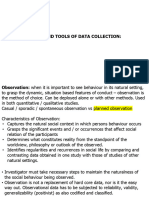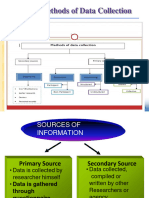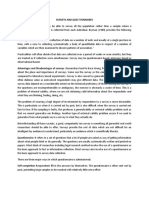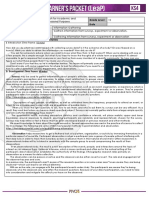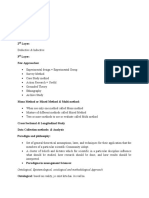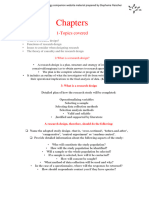OVERVIEW OF
METHODS
UNIT - 1
�RESEARCH METHODS
• To address their research questions, applied social psychologists use a
variety of data collection tools.
• For instance, data may be gathered through mail surveys, face-to-face
or telephone interviews, focus groups, and observations of behavior
in natural settings. We distinguish between two basic and broad
categories of data collection: those that rely on self-report procedures
(e.g., surveys, personality scales, aptitude tests, single-item ratings)
and those that rely on observational procedures (e.g., visual, auditory,
and physiological observations).
�TYPES OF METHODS
• 1. SELF REPORT METHODS.
• 2. SURVEY (INTERNET SURVEY)
• 3. OBSERVATIONAL METHODS
• 4. EXPERIMENTAL METHODS
• 5. CORRELATIONAL METHODS
• 6. DESCRIPTIVE STUDIES
• 7. QUALITATIVE RESEARCH METHODS
�1. SELF REPORT METHODS
• The Special Case of Surveys Self-report data collection procedures are
those that require participants to report (either orally or in writing) on
themselves with respect to the variable(s) of interest.
• Examples of self-report measures include surveys, Personality scales,
Intelligence test, Attitude scales, Aptitude scale, Vocational interest
inventories, and single-item rating scales.
�2. SURVEY
• SURVEY - Surveys involve a series of questions about large group of people to
understand attitudes toward, views on, and behaviors regarding a variable or
set of variables. Like face-to-face interviews, surveys have had a long history
in psychological measurement and continue to be a popular option for social
researchers. Given that the survey is one of the key tools of the applied social
psychologist, it is important to understand how a survey is constructed.
• The following subsections deal with the issues of
1. QUESTION TYPE,
2. WORDING,
3. SEQUENCE, AND
4. RESPONSE FORMATS typically considered in survey development.
� QUESTION TYPE
• There are three basic question types used in surveys:
• 1. FACTUAL,
• 2. ATTITUDE, AND
• 3. BEHAVIORAL.
• FACTUAL QUESTION - If we want to find out about a person’s current
situation or about what has happened to him or her in the past such types
of questions are called factual questions and are used to collect
demographic data (e.g., age, gender, level of education) and information
regarding events or circumstances about which a person is knowledgeable.
�• ATTITUDE QUESTIONS - Attitude questions measure a person’s feelings,
beliefs, or views that often cannot be easily ascertained from his or her
behavior or other sources of information because attitudes are complex,
responses to attitude questions are often difficult to interpret. Attitude
questions must be as specific as possible. For example, a study of attitudes
toward recycling household products should be tackled using a series of
separate questions about the recycling of newspapers, cans, bottles, and so
on.
• BEHAVIOURAL QUESTIONS - behavior questions tap into specific aspects of
current or past behavior such as its frequency, intensity, and timing.
Because they are subject to memory gaps and distortions, behavior
questions are best asked about recent behaviors.
� • QUESTION WORDINGS
• Research shows that even minor differences in question wording can have a
significant impact on responses. Questions have to be worded carefully to avoid
bias or misinterpretation. Listed below are some general guidelines for
developing survey questions.
• These guidelines are not exhaustive and are only meant to give you an idea of
the complexity of question construction in surveys.
• 1. Wording should be exact so that it reflects precisely what you want to
measure.
• 2. Wording/terminology should be simple so that even people with poor literacy
skills, with little education, or from different backgrounds can understand it.
�• 3. Loaded questions should be avoided. Loaded questions are
questions that are phrased so that respondents are led to choose one
response over another (often reflecting the bias of the researcher).
• 4. Questions should be kept short and relatively simple. Do not use
complex lengthy questions that may be hard to understand. It may be
prudent to split such questions into multiple questions. In this regard,
avoid double-barreled questions that involve having more than one
question embedded within a sentence.
• 5. Questions should not make assumptions about respondents such
as about their experiences or demographic status.
� • QUESTION SEQUENCE.
• The sequence of survey questions is important for three reasons. First, you want
to capture respondents’ interest from the beginning and maintain it throughout.
• One way in which to do this is to start with a general, easy-to-answer question
that is both nonthreatening and important to respondents and also is clearly
relevant to the topic of study.
• Unless you are screening for particular respondents (e.g., a specific age group),
never start your survey or interview with demographic questions. These are
boring to respondents and are highly personal.
• Put demographic questions at the end. Second, one question can affect responses
to subsequent questions, a process called a context effect.
� • RESPONSE FORMAT.
• You need to select the format of your responses. There are two basic
response formats:
• 1. Closed-ended (fixed-alternatives) response and
• 2. Open-ended (free) response. Each of these formats serves a
different purpose and carries unique advantages and disadvantages.
�INTERNET SURVEYS
• In the last decade, we have seen a remarkable increase in the use of the Internet or
World Wide Web as a survey mode. There are many types of electronic surveys, each
with its own methodological and statistical implications.
• Particularly relevant to applied social psychologists are electronic surveys that are
employed in research and/or organizational consulting. In a typical procedure, a
sample of individuals from a clearly defined population is notified of a survey by e-
mail, with the questionnaire accessed through a hyperlink or an attachment.
• Electronic surveys have the advantage of combining the benefits of other survey
modes into one format, including being able to reach large numbers of people in a
short time (similar to a telephone), a more interactive question format (similar to in-
person and telephone interviews), and the use of visual cues to help participants
respond accurately (similar to in-person formats). Moreover, because responses are
gathered electronically, data coding and entry can be done quickly.
�2. OBSERVATIONAL METHODS
• Self-report approaches, such as surveys and interviews, are common
means of data collection but are not the only ones. Instead of asking
participants to report about themselves, the researcher may observe
and record some aspect of their functioning.
• Also, the researcher may record actual behavior as it happens (e.g.,
count the number of cars that run a red light at an intersection) or has
happened (e.g., measure floor tile erosion in front of various museum
exhibits as an index of exhibit popularity).
�• The term observation method is used to refer to several different types
of non-experimental studies in which behavior is systematically observed
and recorded. The goal of observational method is to describe a variable
or set of variables.
• More generally, the goal is to obtain in-depth knowledge and information
about the characteristics of an individual, group, or setting.
• Observational method is non-experimental because nothing is
manipulated or controlled, and as such we cannot arrive at causal
conclusions using this approach. The data that are collected in
observational research studies are often qualitative in nature but they
may also be quantitative or both (mixed-methods).
�• PARTICIPANT OBSERVATION - In the method of participant
observation, the researcher is an active participant in the social
situation that he or she has chosen to observe.
• NON PARTICIPANT OBSERVATION - With a different approach,
nonparticipant observation, the researcher remains separate from the
event being observed so as not to influence (i.e., contaminate) the
natural behavior and dynamics of the situation. The researcher can
engage in nonparticipant observation either by observing the
behavior of interest directly or by gathering observations through
indirect means.
�EXPERIMENTAL METHOD
• A true experimental method allows the researcher to assess whether,
and the degree to which, a variable (the possible cause) manipulated
by the experimenter leads to a change in another variable (the effect).
• There are three kinds of variables relevant to experiments:
• 1. INDEPENDENT,
• 2. DEPENDENT, AND
• 3. EXTRANEOUS.
�• INDEPENDENT VARIABLE - An independent variable is one that is
actively manipulated (i.e., changed) by the experimenter.
• DEPENDENT VARIABLE - A dependent variable is one that is measured
by the experimenter to determine if it changes in response to the
manipulation of the independent variable.
• EXTRANEOUS VARIABLE - An extraneous variable is one that the
experimenter wishes to hold constant across levels of the
independent variable so as to rule it out as a possible reason why the
dependent variable changes in accordance with the manipulation of
the independent variable.
�CORRELATIONAL STUDIES
• Our research questions often address the relationships among variables. To address
these questions, we can use a correlational study.
• A correlational study involves measuring variables and determining the correlation
between them. A correlation coefficient is a measure of the degree of association
between different variables, so that knowing one thing about a person may tell you
something else (e.g., knowing a person’s height may let you predict his or her shoe size).
• Mathematically, correlation coefficients (denoted by r) range from −1 to +1. This
boundary allows us to compare coefficients and understand both the strength and the
direction of the relation between two variables.
• When two variables are positively correlated (r > 0), high values of one variable typically
are found among high values of the other variable (and, of course, low values of one
variable typically are found among low values of the other variable), so that the values
of the variables move together in the same direction.
�DESCRIPTIVE STUDIES
• In Descriptive research, the objective is to observe variables and
summarize the observations by using descriptive statistics such as
means, frequencies, and percentages.
• With a purely descriptive approach, you shall lack the ability to
determine why the behavior occurs. Nevertheless, the scope of
questions that descriptive designs can address is quite vast.
�QUALITATIVE RESEARCH METHODS
• Sometimes, however, researchers are more interested in probing the interpretations
people have of situations and the meanings they attach to them. In these
circumstances, qualitative research methods are more appropriate.
• Qualitative research methods represent the “means for exploring and understanding
the meaning individuals or groups ascribe to a social or human problem” (Creswell,
2009).
• Creswell (2007) enumerates five qualitative research methods.
• 1. NARRATIVE RESEARCH - Narrative research focuses on gathering detailed stories
about one individual or a small number of individuals. It involves collecting data on
the stories or events through observation, interviews, letters, and other artifacts, and
then — reorganizing the stories into a coherent framework—taking context (e.g.,
personal, cultural, historical) into account. Narrative research would also be used to
produce someone’s biography
�• 2. PHENOMENOLOGICAL METHOD - Phenomenological research involves
gathering the stories of a group of people in order to ascertain what
experiences they have in common when they live through some specific
phenomenon (e.g., getting dumped, being bullied at work).
• The purpose of phenomenological research is to generate an integrated
account of the essence of the experience by drawing on textural description
(what was experienced) and structural description (the context in which it was
experienced).
• In order to accomplish this, the researcher is expected to try to “bracket out”
his or her own experiences, or at least make them explicit so as to minimize
their interference with the analysis. Data gathering usually takes the form of
multiple interviews but can also involve observations and various artifacts.
�• GROUNDED RESEARCH METHOD - The purpose of grounded theory is to move
beyond people’s accounts of their experiences in order to formulate a theory of
people’s actions, interactions, and social processes as they pertain to a particular
topic. The fundamental idea is that the theory is not arbitrarily developed, but
instead is “grounded” in the accounts of those who have experienced the
phenomenon under investigation.
• In brief outline, the researcher conducts interviews with people who have
experienced a phenomenon and tries to generate categories that capture the
fundamental aspects of the experience. Once categories are developed, the
researcher conducts more interviews in an iterative fashion until no new
information that helps to clarify the categories is forthcoming, and the theory is
fully developed. If desired, the theory can then be tested using quantitative
methods.
�• ETHNOGRAPHIC RESEARCH - Ethnographic research focuses on the description and
interpretation of the shared values, beliefs, behaviors, and language of a specific
intact cultural group (e.g., teachers at an elementary school, gang members). This
qualitative research method typically involves participant observation, and
interviews also are commonly used. The researcher attempts to uncover patterns in
events, social relations, and other cultural themes in the lives of the group members
in order to produce a cultural portrait of the group.
• CASE STUDIES - Case studies involve the investigation of a particular issue within a
specific context, for example, examining why a patient failed to take her medicine as
prescribed and became seriously ill. Case studies employ many different data
gathering techniques, including interviews, the examination of archival records,
observation, and anything else that can elucidate the issue. The ultimate product of
a case analysis is a report outlining what has been learned about the issue.
�• MIXED METHOD (TRIANGULATION)- One last point we should
highlight is that, as suggested in the discussion of grounded theory,
qualitative research methods and quantitative research methods can
be used in tandem. This mixed-method approach can produce studies
that are stronger than what can be achieved by relying on one
method exclusively (Creswell, 2009).
• Many issues and problems dealt with by applied social psychologists
are complex and multifaceted, and drawing on both qualitative and
quantitative methods often enables researchers to achieve a more
complete understanding of them.
��RESEARCH ETHICS
�• American Psychological Association (2010) has a set of guidelines for researchers to
follow with respect to deception and other ethical issues: Ethical Principles of
Psychologists and Code of Conduct. Following are some of the main principles:
• 1. RESPECT FOR THE DIGNITY OF PERSONS - As the central ethical principle,
psychologists’ respect for human dignity underlies all of the others. Note, for instance,
that we refer to those persons who take part in a study as “participants” rather than as
“subjects” because it reflects the dignity and respect afforded to the people we study.
• 2. MINIMIZATION OF HARM AND REDUCTION OF RISK - Psychologists must take steps to
avoid harming participants.
• 3. INFORMED CONSENT - Researchers should describe the procedures to participants
before they take part in a study, including any factors that might affect their willingness to
participate, and they should document participants’ agreements to take part in the study.
�• 4. FREEDOM TO WITHDRAW - Participants must be informed that they are free to
withdraw from a study at any point with no negative consequences for doing so.
• 5. PRIVACY AND CONFIDENTIALITY. All information obtained from individual
participants must be held in strict confidence. Confidentiality refers to restricting
access to the data and to releasing results in such a way that each individual’s privacy
is not violated.
• 6. MINIMAL USE OF DECEPTION - Deception may be used only if the research has
potential value (scientific, educational, or applied) and if there are no other viable
means of investigating the research questions or hypotheses. Also, it can be used only
if it does not put participants at undue risk and if, as soon after completion of the
study as is feasible, participants are provided with a full description (i.e., debriefing)
of the study’s true purpose; an explanation of all procedures, including the need for
deception; and an opportunity to withdraw their data.




